Preston Lewis's Blog, page 6
February 16, 2017
O.K. Song
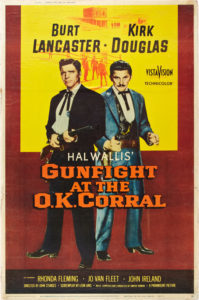
Movie Poster
Over the weekend I had occasion to re-watch Gunfight at the O.K. Corral, the 1957 movie that I first saw at the Yucca Theater in Midland, Texas, when I was a kid. It was a wonderful movie that holds up well even today for pure entertainment. What I remember most about the showing that night was the little corral the management had constructed outside the theater from cedar posts and the striking theme song of the same name performed by Frankie Laine.
It was an entertaining movie, though bad history. Little did I know then as I watched the film that I would one day write two novels about various characters in the movie. Of course, what western writer hasn’t written about Wyatt Earp, Doc Holliday and, to a lesser extent, Lottie Deno, who is called Laura Denbow in the movie?
The movie begins in Fort Griffin, Texas, where Holliday and Earp supposedly first met, then moves to Dodge City before reaching Tombstone and the climactic gunfight of the Old West. Though the movie shootout fires away for over five minutes, the actual gunfight lasted but 30 seconds. Like I say, it was bad history, but even bad history takes time. The five minutes of exaggerated gunplay in the movie’s climatic showdown took four days to film. Even though the movie lacked factual fidelity in many instances, it was a major hit, earning $4.7 million in 1950s dollars and another $6 million in re-release.
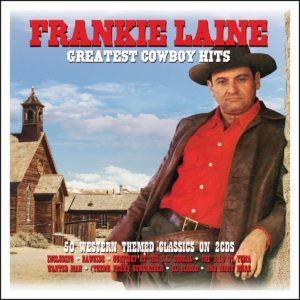
Album Cover
Kirk Douglas remains my second favorite Doc Holliday behind Val Kilmer’s in Tombstone. Burt Lancaster is an acceptable Wyatt Earp, even minus the mustache the real Wyatt Earp sported when his 30 seconds of gunplay earned him eternal fame. The female leads in the film were Rhonda Fleming as Laura Denbow and Jo Van Fleet as “Big Nose” Kate Fisher. Other actors in the movie included Earl Holliman, Dennis Hopper, Martin Milner, Lee Van Cleef and Jack Elam.
The movie was nominated for two Oscars – Best Sound Recording and Best Film Editing – but came away empty-handed at the ceremony. I always thought the theme song should have been nominated, but it was overlooked. I got my chance decades later to show my appreciation for the movie’s theme song when I voted Frankie Laine’s rendition in my top five in the Western Writers of America survey of the Top 100 Western Songs. Gunfight at the O.K. Corral wound up in the middle of the listing at No. 50. I guess know more about history than music!
December 31, 2016
Billy the Kidder
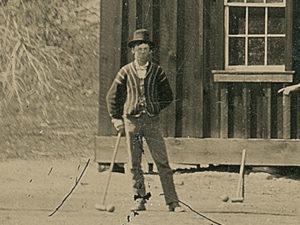
Croquet Billy
Some 135 years after his demise, Billy the Kid has made me a published poet, proving once again the long reach of the buck-toothed New Mexico outlaw. My trail to writing poetry began in October 2015 with a National Geographic documentary narrated by Kevin Costner and claiming to have found a new tintype of Billy playing croquet.
After viewing the documentary, I concluded it was Billy. Then in February of 2016, True West came out with a cover story “This Image Could Be Billy. Really?”
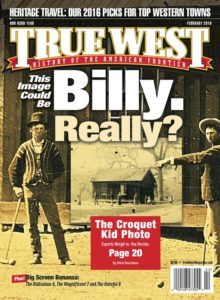
February 2016
After reading True West’s case against the validity of the documentary’s conclusions, I decided the weight of evidence, including a lack of a clear provenance, was 99.99 percent against the sweater-clad croquet player actually being the Kid. Nice try but there have been several Billy the Kid imposters over the years, including most famously Brushy Bill Roberts of Hico, Texas.
Then it hit me that perhaps both sides could be right, inspiring me to write “Billy the Kidder,” which appeared in the December issue of the Journal of the Wild West History Association.
Billy the Kidder
Billy was a Kidder, as everybody knows.
He rode through Lincoln County, giving one-man shows.
Audiences all loved him, every prank and joke.
Stand-up was easier than being a cowpoke.
Billy was a Kidder, you’ve got to understand.
He honed his art and
craft to tickle every fan.
Performing at the Wortley and Mesilla Courtroom, too,
Billy was wanted for the humor he would do.
Billy was a Kidder, he often left them dead
’Cause you could die of laughter from what Billy said.
Morton and Baker plus Bell and Olinger, too,
Met their Maker giggling at what Billy could do.
Billy was a Kidder, who worked hard for his gigs
Even doing weddings and occasional shindigs.
Once his jokes had ended, he then took to dancing
Rather than working on tintype provenancing.
Billy was a Kidder, who earned his sobriquet,
Even finding time to play a little croquet.
With mallet, hoops, pegs and a colored wooden ball
He out-shot his opponents, every one and all.
Billy was a Kidder, a photog did agree
And asked to make a tintype for posterity.
Billy said yes with but a single caveat
To a croquet photo destined for a pawn shop.
Billy was a Kidder, Nat Geo didn’t b’lieve
So Kevin Costner voiced their documentary.
Once on television, it must always be right.
Those who think otherwise are certainly not bright.
Since Billy was a Kidder, the image can’t be true
’Cause Billy had a plan for fooling me and you.
When croquet matching or visiting Blazer’s Mill,
Billy used a stand-in by the name of Brushy Bill!
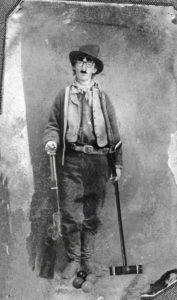
Billy the Kidder
After completing the poem, I began to look for a photo to accompany the piece. To my surprise, I miraculously stumbled across one locally at Ye Olde PhotoShoppe. Though I don’t have the provenance on it, it seems to me to be Billy and I am looking for a buyer.
November 16, 2016
Killing Custer
I have just sent to my publisher, Wild Horse Press, the manuscript for the fourth book in The Memoirs of H.H. Lomax series. This book explores Custer and the Little Bighorn with Lomax right in the middle of things. In fact, if Custer had only listened to Lomax, things might have turned out differently that fateful Sunday afternoon. This is how I started the manuscript:
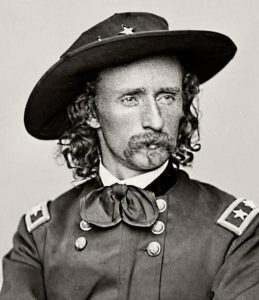
George Armstrong Custer
“My aim was to shoot George Armstrong Custer, not to make him famous. Maybe I shot him and maybe I didn’t. I never knew because it was hard to confirm if you hit your target when hundreds of screaming Sioux and Cheyenne warriors were also firing at him—and at me. But the fact is, I held more rancor for Custer on that hot, dusty day in June of 1876 than I did for the Indian braves committed to scalping me. In the end, you might say that both God and the devil saved me from the fate of the other white men on the hill above the Little Bighorn that afternoon.
“I didn’t care for Custer, general or colonel or lieutenant or whatever his rank was. Fact was, I called him ‘General Bluster’ because there weren’t enough mirrors in the world to adequately reflect his opinion of himself. And my low opinion of the man did little to narrow the waistline of his bulging vanity. In fact, he relished telling me how superior he was to me, him being of Yankee descent and attending West Point, while I was a poor Southern boy with a narrow education. I could read, I could write and I could think. Custer could, too, but he liked to read about himself, write about himself and I imagine, if I could have read his mind, that he liked to think about himself as well. Fact was, if you had ordered a thousand sons of bitches from a Chicago mail-order house and only received him, you’d mark your bill paid in full.”
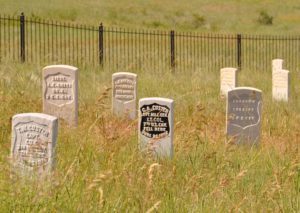
Custer Marker on Last Stand Hill
George Armstrong Custer remains one of the most controversial figures in American history, some folks adoring him, others despising him. I side with his detractors, finding him an arrogant, vainglorious narcissist, his unquestioned bravery outweighed by his impetuous nature and his imperious treatment of his men. My friend and distinguished western historian Robert M. Utley once said something to the effect that opinions on Custer say more about the beholder than the beholden. That is certainly true for there is much to like and even more, in my mind, to despise about the general.
The great thing about writing fiction is that the novelist can choose the facts he likes and ignore the ones he doesn’t to paint his picture of people and events. There was so much good and bad about Custer that it was easy to make him the foil of my protagonist, H.H. Lomax.
Tentatively titled Bluster’s Last Stand, the comic western novel will be out next summer.
October 4, 2016
The Times It Never Rained
I have a long history with True West so it is always nice to get a byline in the magazine. The October issue carries my story “The Deadliest Enemy” on how Texas ranchers survived the two major droughts of the late 19th century. It was a fun story to research and shows how serious droughts were to 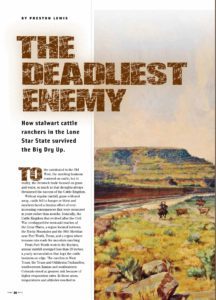 ranches and the ingenuity that helped ranchers survive.
ranches and the ingenuity that helped ranchers survive.
If you are interested, you can read the web version of “The Deadliest Enemy.”
True West was one of the magazines my father subscribed to when I was growing up so I looked forward to every issue of both it and Frontier Times. The magazine stories helped foster in me a love of the history and lore of Texas and the West. Little did I realize then that I would one day be published in True West and actually win a few awards for those stories. So, it’s always nice to see my name in True West.
When I was a boy reading Dad’s True West, it was printed on a cheap pulp paper and all black and white, except for the cover. Today it is a slick magazine and the layout and art for “The Deadliest Enemy” are the best for any freelance publication I’ve ever had.
My next article on the Old West is, oddly enough, a story of cats on the frontier. Titled “The Cat-astropic West,” the story is scheduled for the December issue of the Journal of the Wild West History Association.
Coming in at 7,500 words, it may be the first major work on cats in the Old West as there aren’t a lot of books (I couldn’t find a single one) on the subject. Fortunately, I was able to scour enough old newspapers to uncover plenty of information for a good article and find a few books or journals with passing references to cats.
On top of that, I only used about 40 percent of my information so this topic will have other iterations in the future. I’m not a cat person, but I am a fan of good stories. The story of cats in the Old West is filled with the sad, the practical, the unbelievable and the humorous, just the type of tale I like to write.
September 24, 2016
Lottie’s Luck
Since June I’ve been researching and writing a screenplay based on one of my early books, The Lady and Doc Holliday. The timing has been good because Lady is returning to print with a superb cover, unlike the original. I re-read the book twice in the process of adapting it to a screenplay, my first. As a result, I’ve learned a lot.
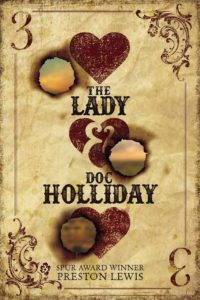
New Book Cover
First, I’ve improved as a writer, which is good since it was written 30 years ago. As I re-read it, I saw it was grittier than I would write today. Further, I realized that Doc Holliday, one of my favorite western characters of the Old West, is not very likable. I wrote it at a time when I was frustrated that my books were not getting published. Consequently, I wrote a historical novel that I tried to make realistic to the time.
The most memorable review of the book came from Mildred McRorey, my oldest paternal aunt and an inveterate reader. She wrote me that it was “a bit ronchy!” (sic) That assessment from my Sunday School-teaching aunt bothered me for a while until we visited her Blackwell home and I picked up one of the romance novels she always enjoyed. Let’s just say it was “steamy” and I was shocked. I guess it’s one thing when a stranger generates steam versus your nephew.
The second thing I have learned is that writing a screenplay is different than writing a book. That would seem obvious, but it doesn’t really sink in until you sit down and try it. I now understand why movie adaptations are not always true to the original book. A book doesn’t always convert to the screen because of the accepted parameters of a standard screenplay, which is generally limited to 40 segments or beats, as they are called in the trade. Lady had almost twice that many segments when I broke it down as well as complicated gambling sequences. It was not a one-for-one conversion.
Another thing, the book title was given by the publisher to capitalize on the name of Doc Holliday. It makes for a bad movie title, however. The screenplay title reverts to my original title, Lottie’s Luck.
When I first wrote the novel, the only real option for screenplays was Hollywood, but with the rise of cable, independent producers, streaming and other video venues there are more opportunities to sell screenplays, though they will generally play to a more segmented audience.
While the screenplay is being written on speculation, I was encouraged to give it a shot by a producer I met at the Western Writers of America meeting back in June. It’s due a week from Monday and all I lack is a final reading before sending it off. Like all creative endeavors, it is a longshot, but then again so was The Lady and Doc Holliday when I first wrote it. Whatever ultimately results, it has been an interesting and challenging writing experience.
September 9, 2016
Western Sting
My latest comic western The Fleecing of Fort Griffin is now available in trade paperback and e-book formats through online retailers.
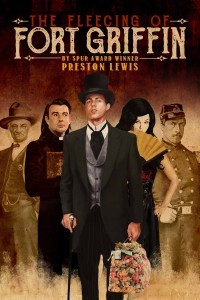
Book Cover
Set in 1878 on the West Texas frontier, the novel begins when Baron Jerome Manchester Paget arrives in Fort Griffin with a satchel-full of money intent on starting a buffalo ranch and finding a bride. Swindlers from throughout Texas converge on Fort Griffin to help the rube Englishman “invest” his riches. To realize his buffalo ranching and marital dreams, however, the naïve baron must stay alive in a dangerous frontier town.
In the book trade, The Fleecing of Fort Griffin is considered a “caper” but I describe it as a western “Sting,” as it takes readers on an comic journey with more twists and turns than a stagecoach trail. Along the way, a bevy of oddball characters, including aging gunfighter One-Eyed Charlie Gatliff, itinerant preacher Rev. G.W. “God Willing” Tuck, black widow Flora Belmont, gambler Joe Loper, virginal harlot Lop-Eared Annie Lea and husband-and-wife con artists Wallace and Amanda Sikes, among others, try to outsmart the naïve baron and each other.
Pursued by men who want to kill him and women who want to marry him, the unconventional Baron Jerome Manchester Paget can find only one true friend – 14-year-old orphan Sammy Collins – among all of Fort Griffin’s inhabitants. Collins watches the confluence of con artists with a wide-eyed innocence, dreaming that the baron will one day take him away from his dreary existence in Fort Griffin.
Whatever and whenever I’m reading I always look for interesting facts or stories I can work into my novels. Years ago I was reading original frontier papers from Jacksboro and Fort Griffin for background on another project when I read a column by an editor, addressing the great theological questions of the time. The one that caught my attention and brought a laugh was whether a convert’s cork leg must be fully immersed for a Baptist baptism to take.
Remembering that story from years ago, I used it in Fleecing when I had Rev. Tuck attempt to baptize Zadocks Crawley and his cork leg with predictable comic results. I set this scene in the Concho River not far from our home in San Angelo. As a nod to my publisher – Wild Horse Press of Fort Worth – I introduce Wallace and Amanda Sikes, who run a honey-pot scam, in a Cowtown hotel. Those are the types of games authors play to amuse themselves when we write.
The Fleecing of Fort Griffin is available on Amazon for $19.95 in trade paperback and for $5.99 on Kindle. Wild Horse Press publishes western history and fiction as well as Texana.
August 23, 2016
Tie-In Writer
It seems I was a wanted man for almost two decades, and I didn’t even know it. Besides that, in the end I wound up outing myself and getting fingered for writing three books. As a result, I am now a new member of the International Association of Media Tie-In Writers (IAMTI).
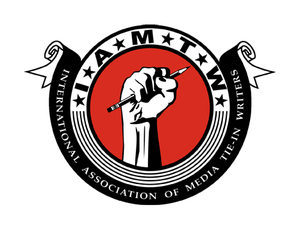
IAMTW Logo
This story began two decades ago when Bantam Books asked the late Frank Roderus and me to write three books apiece, based on the Bonanza television series. We wrote them under the house name “Stephen Calder” and apparently set off an immediate search for the true identity of the non-existent Calder by another tie-in writer. The secret held until I started my author’s blog and did a piece on literary aliases in April of last year.
IAMTW member David Spencer had been searching for the real “Stephen Calder” for years and googled the name earlier this month, as he had done periodically for the past two decades. His latest search connected to the “Aliases” blog on my website and outed me as one of the writers of the 1990s Bonanza series for Bantam.
Tie-in writers are authors licensed to produce books based on other media, primarily movies and TV shows, 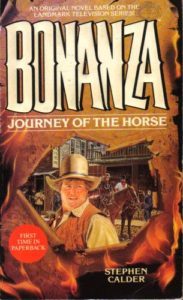 but also comic books and even games. Since I had written books in the Bonanza series, I qualified for membership. What made the offer flattering was that the invitation was extended by Lee Goldberg, who did a lot of the novelizations of the Monk television series, and Max Allan Collins, one of my favorite historical fiction writers for his Nathan Heller detective series, which puts his Chicago private eye in the middle of such legendary events as the Lindbergh kidnapping and the Bugsy Siegel murder.
but also comic books and even games. Since I had written books in the Bonanza series, I qualified for membership. What made the offer flattering was that the invitation was extended by Lee Goldberg, who did a lot of the novelizations of the Monk television series, and Max Allan Collins, one of my favorite historical fiction writers for his Nathan Heller detective series, which puts his Chicago private eye in the middle of such legendary events as the Lindbergh kidnapping and the Bugsy Siegel murder.
Writing tie-ins is an art in itself and not as easy as you might think because the translation from one medium to another presents a variety of challenges. Too, the tie-in authors work under certain restrictions mandated by the rights owners. When I worked on the Bonanza series, I had Hop Sing visit an Opium den in search of someone, but the rights owners felt that inappropriate for their property, even if it had been a historical possibility. So, that was changed as it should have been at the request of the rights holders.
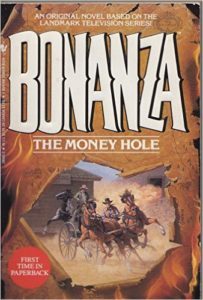 Perhaps the best example of how tie-ins can work was illustrated by IAMTW member Paul Bishop, who reported on the book The Man in Black, which became the 1967 Dean Martin/George Peppard movie Rough Night in Jericho. The movie was different enough from the original book that a tie-in book was written under the movie’s title. As Bishop put it, “A book based on a movie that was based on a different book does not happen often.” Even so, it does illustrate the possibilities and permutations of tie-in writing.
Perhaps the best example of how tie-ins can work was illustrated by IAMTW member Paul Bishop, who reported on the book The Man in Black, which became the 1967 Dean Martin/George Peppard movie Rough Night in Jericho. The movie was different enough from the original book that a tie-in book was written under the movie’s title. As Bishop put it, “A book based on a movie that was based on a different book does not happen often.” Even so, it does illustrate the possibilities and permutations of tie-in writing.
So, it was an honor to be invited by such established writers as Goldberg and Collins to join IAMTW based on such modest credits.
July 25, 2016
Holliday Road
Of all the Old West characters I have encountered in my readings over the years, Billy the Kid and Doc Holliday remain my two favorite, so I was excited to learn that Karen Holliday Tanner, the closest living relative to Doc Holliday, was attending the recent Wild West History Association meeting in Oklahoma City.
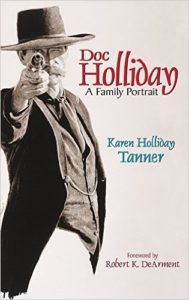
A Family Perspective on Doc Holliday
Karen had published Doc Holliday: A Family Portrait with the University of Oklahoma Press in 1998. Based on family records and reminiscences, her book fleshed out Doc Holliday’s early years and put in context his battle with tuberculosis and how it shaped the western persona that has become the grist for both western fiction and nonfiction.
Spotting Karen during one of the breaks at the WWHA meeting, I walked over and introduced myself. I was pleased when I told her my name and she remembered me as authoring The Lady and Doc Holliday. As I explained how much I liked her book and how I considered Doc Holliday one of my favorite personages of the Old West, she smiled and said he was atypical for the Old West, being well-educated and genteel. Had he not contracted tuberculosis and moved west for his health, he might have lived out his life as a dentist in obscurity. Instead he became a frontier legend, who lived a dangerous life yet died peacefully in bed from the ravages of tuberculosis.
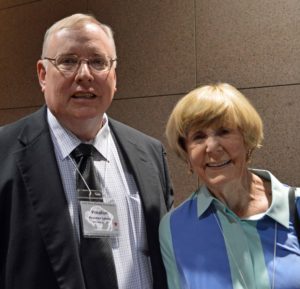
Preston Lewis and Karen Holliday Tanner
My interest in Doc Holiday is reflected in the fact that he is the only historical character I have used in two of my novels—The Lady and Doc Holliday and Mix-Up at the O.K. Corral. To my knowledge, my protagonist in Mix-Up—H.H. Lomax—is the only fictional character ever to have a tooth pulled by Doc Holliday.
My meeting with Karen Holliday Tanner along with previous introduction to Pamela Fuller Potter means I have met kin to combatants on both sides of the dispute culminating with the gunfight at the O.K. Corral. Despite the tensions of the 1880s that led to the fateful and classic gunfight, I can report there were no further fireworks among the kin at WWHA.
July 12, 2016
A Fan with Connections
Over the years I have learned that being an author has its flattering moments, none more so for me than at my first Wild West History Association (WWHA) meeting this month in Oklahoma City. We went at the encouragement of Mike Cox, a longtime writer friend, Texas Rangers expert and editor of the association’s journal.
When we met up in OKC with Mike and Beverly, he told me that a member of the board was anxious to meet me. So, at the opening reception I was seated at a table visiting with a newfound friend when I saw a woman out of the corner of my eye approach Mike and overheard her ask if I was there. Mike told her that was me sitting across the table from him and then escorted her over to meet me.
Her name is Pamela Fuller Potter and she is a past president of WWHA from Mountain Center, California.
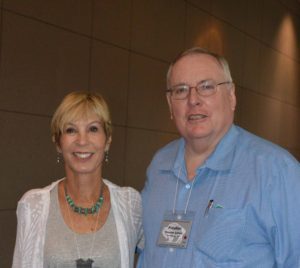
Pam Potter with Preston Lewis
Pam proceeded to tell me how much she loved Mix-Up at the O.K. Corral. Not only that, the book remains one of her favorite books of all time, especially fiction since she generally reads nonfiction. I was greatly flattered that she would remember the book since Mix-Up was published two decades ago this year and had a limited shelf-life as a mass market paperback from Bantam.
As we talked, she explained the backstory. Her great grandmother was the younger sister of Tom and Frank McLaury, who along with Billy Clanton died in the shootout with the Earp Brothers and Doc Holliday at the O.K. Corral on October 26, 1881.
Pam explained that there was no love for the Earp faction in her home growing up as they were not heroes to the McLaury descendants. Thus, she greatly enjoyed my unvarnished look at the Earps through the eyes of my protagonist, H.H. Lomax in Mix-Up, which starts out like this:
Things might have turned out different in Tombstone if I hadn’t had a toothache and Doc Holliday hadn’t had bad breath. A lot of men died as a result, though not likely as many as needed killing. If it hadn’t been my tooth, though, it’d probably have been something much less important that started all the trouble because there were more mean folk in Arizona Territory at the time than you’d find any place else in the country short of a suffragists’ convention.
The law was crooked in Tombstone, and it didn’t matter what side of the law you were on. The politics were crooked in Tombstone, too, which made it no different from most every other place else in the country. You couldn’t even buy a town lot without some greasy son of a bitch trying to claim it for himself. Nothing was straight in Tombstone, not even the liquor. I knew that for certain because I owned a saloon there, and I’d cut my whiskey with just about anything I could, even water—which was expensive at three cents a gallon—when nothing else was available.
Running a saloon is as respectable an occupation as, say, running for political office, and you get to meet a higher class of people. That’s how I met Doc Holliday, who threatened to cut out my gizzard, and Johnny Ringo, who offered to blow a hole in me wide enough to drive an ore wagon through, and the Earp brothers, who were rightly named because I always felt like throwing up around them. They made me that nervous because I never knew what side of anything they were on, save their own.
When you write historical fiction as I do, you seldom remember that people long deceased often have living links to the present through their family descendants. My new friend Pam Potter reminded me of that. Later, I would meet kin on the other side of the fabled shootout, but that is a story for another day.
June 5, 2016
A Fickle Mistress
History can be a fickle mistress, especially when you learn it wasn’t so! Years ago, I fell in love with the photograph and story of Lottie Deno, a mysterious yet virtuous female gambler who maintained her purity as she traveled to some of the roughest towns in frontier Texas. Then she just disappeared from Texas.
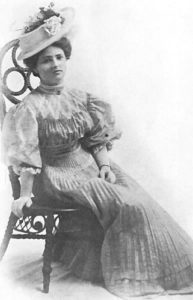
Lottie No More
The photo of her is striking, especially when compared to some of her female gambling contemporaries such as Poker Alice, and I decided to do my first historical novel on her because she seemed like a virtuous woman in an unvirtuous frontier world.
Though her legend was well known, J. Marvin Hunter, who knew her in her later years in New Mexico, published in 1959 The Story of Lottie Deno: Her Life and Times, her first biography. Though some historians like my longtime friend Ty Cashion had previously begun to pull back Miss Deno’s veil of purity with his A Texas Frontier: The Clear Fork Country and Fort Griffin, 1849-1887, along comes Jan Devereaux to tear that veil to shreds and in the process rip up the photo I had fallen in love with.
I had the opportunity to meet Devereaux at the Lone Star History Conference last month in Waco and to buy her Pistols, Petticoats & Poker: The Real Lottie Deno, No Lies or Alibis to add to my Lottie Deno library. Devereaux has done an admirable job of research in putting together the best documented account of Lottie’s actual life. Miss Deno was not as pure as people’s memories, certainly she was a madam with multiple arrests for running a “disorderly house,” a Victorian and legal euphemism for brothel. She was likely a prostitute during at least some of her stay in Texas.

Jan Devereaux
Most discouraging, Devereaux had the photo analyzed by historical fashion experts, who indicated the dress and hat were typical early 20th century attire rather than middle 19th century dress when Lottie would’ve been the age of the striking woman in the photo. So much for my love affair with Lottie Deno, who left Texas in the late 1870s and ultimately reappeared in Deming, New Mexico, as Charlotte Thurmond, a respectable local matron and Episcopalian.
Her legend was so appealing that she has appeared in several fictional iterations since her 1934 death. I wasn’t even the first Lewis to write about her as Alfred Henry Lewis first immortalized her as Faro Nell in his Wolfville books between 1893 and 1913. Lottie was the model for Laura Denbo, played by Rhonda Fleming in the 1957 Paramount release Gunfight at the OK Corral, starring Burt Lancaster and Kirk Douglas. Lottie is also thought to be the model for Miss Kitty as played by Amanda Blake in the long-running Gunsmoke television series.
I am pleased to report my Lottie book—The Lady and Doc Holliday—will return to print later this year, even if the photo that sold me on her story is not her after all.



